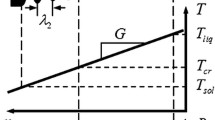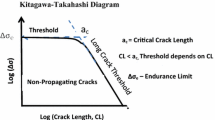Abstract
A new criterion for the appearance of hot tears in metallic alloys is proposed. Based upon a mass balance performed over the liquid and solid phases, it accounts for the tensile deformation of the solid skeleton perpendicular to the growing dendrites and for the induced interdendritic liquid feeding. This model introduces a critical deformation rate (\(\dot \varepsilon _{p,\max } \)) beyond which cavitation, i.e., nucleation of a first void, occurs. As should be expected, this critical value is an increasing function of the thermal gradient and permeability and a decreasing function of the viscosity. The shrinkage contribution, which is also included in the model, is shown to be of the same order of magnitude as that associated with the tensile deformation of the solid skeleton. A hot-cracking sensitivity (HCS) index is then defined as \(\dot \varepsilon _{_{p,\max } }^{ - 1} \). When applied to a variable-concentration aluminum-copper alloy, this HCS criterion can reproduce the typical “Λ curves” previously deduced by Clyne and Davies on a phenomenological basis. The calculated values are in fairly good agreement with those obtained experimentally by Spittle and Cushway for a non-grain-refined alloy. A comparison of this criterion to hot cracks observed in ring-mold solidification tests indicates cavitation depression of a few kilo Pascal and tensile stresses in the coherent mushy zone of a few mega Pascal. These values are discussed in terms of those obtained by other means (coherency measurement, microporosity observation, and simulation). Even though this HCS criterion is based only upon the appearance of a first void and not on its propagation, it sets up for the first time a physically sound basis for the study of hot-crack formation.
Similar content being viewed by others
References
W. Kurz and D.J. Fisher: Fundamentals of Solidification, 3rd ed., Trans Tech Publications, Aedermannsdorf, Switzerland, 1989.
J. Campbell: Castings, Butterworth-Heinemann, Oxford, United Kingdom, 1991.
T.S. Piwonka and M.C. Flemings: Trans. AIME, 1966, vol. 236, pp. 1157–65.
K. Kubo and R.D. Pehlke: Metall. Trans. B, 16B (1985) 359–66.
J. Ampuero, Ch. Charbon, A.F.A. Hoadley, and M. Rappaz: in Materials Processing in the Computer Age, V.R. Voller, M.S. Stachowicz, and B.G. Thomas, eds., TMS, Warrendale, PA, 1991, pp. 377–88.
T.W. Clyne and G.J. Davies: Br. Foundryman, 1981, vol. 74, pp. 65–73; Br. Foundryman, 1975, vol. 68, pp. 238–44.
F. Matsuda, H. Nakagawa, S. Katayama, and Y. Arata: Trans. Jpn. Weld. Soc. 13 (1982) 115–32; Trans. Welding Res. Inst., Osaka Univ. 6 (1977) 197–206; Trans. Welding Res. Inst., Osaka Univ., 5 (1976) 135–51.
U. Feurer: Giesserei Forsch., 2 (1976) 75–80.
R. Jauch: Stahl Eisen 98 (1978) 244–54.
T.W. Clyne, M. Wolf, and W. Kurz: Metall. Trans. B, 13B (1982) 259–66.
Y.F. Guven and J.D. Hunt: Cast Met., 1 (1988) 104–11.
D. Warrington and D.G. McCartney: Cast Met., 2 (1989) 134–143.
J. Campbell and T.W. Clyne: Cast Met., 3 (1991) 224–26.
J.-M. Drezet and M. Rappaz: in Modeling of Casting, Welding and Advanced Solidification Processes VIII, B.G. Thomas, C. Beckermann, and I. Ohnaka, eds., TMS, Warrendale, PA, 1998, pp. 883–90.
Guocai Chai: Ph.D. Thesis, Chem. Communic., Stockholm, 1994, No 1.
P. Vicente: Ph.D. Thesis, Ecole Nationale Supérieure des Mines de Paris, Paris, 1994.
P. Ackermann, W. Kurz, and W. Heinemann: Mater. Sci. Eng., 75 (1985) 79–86.
W. Kurz: private communication, Ecole Polytechnique Fédérale de Lausanne, Switzerland, 1996.
H. Esaka, W. Kurz, and R. Trivedi: in Solidification Processing, J. Beech and H. Jones, eds., Institute of Metals, London, 1988, pp. 198–201.
C.Y. Wang and C. Beckermann: Metall. Trans. A, 24A (1993) 2787–2802.
E. Niyama, T. Uchida, M. Morikawa, and S. Saito: AFS Int. Cast Met. J., 1982, Sept., pp. 52–63.
J.A. Spittle and A.A. Cushway: Met. Technol., 1983, vol. 10, pp. 6–13.
P. Rousset, M. Rappaz, and B. Hannart: Metall. Trans. A, 1995, vol. 26A, pp. 2349–58.
Author information
Authors and Affiliations
Rights and permissions
About this article
Cite this article
Rappaz, M., Drezet, J.M. & Gremaud, M. A new hot-tearing criterion. Metall Mater Trans A 30, 449–455 (1999). https://doi.org/10.1007/s11661-999-0334-z
Received:
Issue Date:
DOI: https://doi.org/10.1007/s11661-999-0334-z




